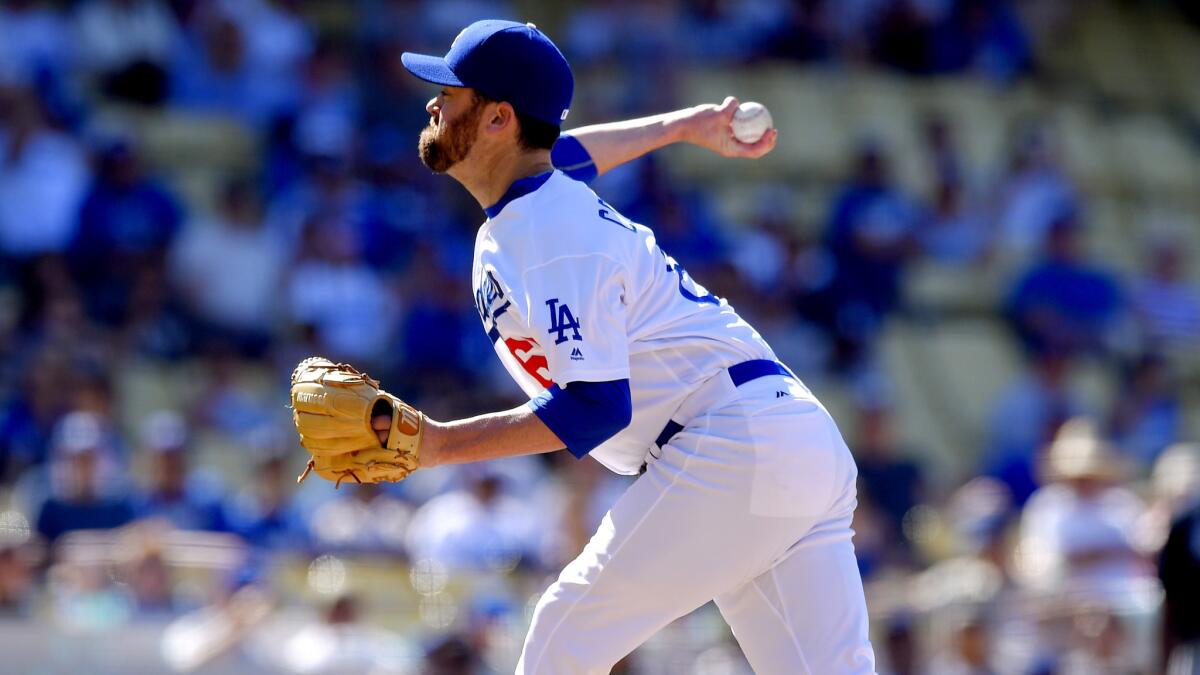Dodgers relievers are meeting the challenge

Dodgers reliever Louis Coleman delivers a pitch against the Braves last Sunday.
- Share via
Once the padded door swung open, activity in the Dodgers bullpen never stopped. Arms stretched, warmup pitches popped into the bullpen catcher’s mitt and four relievers eventually jogged from the left-field corner to the mound.
It all looked routine, if not rehearsed.
The result was three innings to finish a shutout of the Colorado Rockies on Friday night, another solid performance from a bullpen on which the Dodgers have been leaning a lot.
“Everyone knows what they’re being asked to do, man,” Dodgers closer Kenley Jansen said Saturday. “Whether it’s three innings we need to get done, or four, or two, there’s some idea of what needs to happen and we just get going when called upon.”
With the midway point of the season passed, and the All-Star game coming at the end of this 10-game homestand, the Dodgers’ once-shaky bullpen leads the National League with a 3.02 earned-run average and .199 opponents’ batting average. The group has continued to improve as the workload has steadily increased.
The bullpen was at its best while throwing 931/3 innings in June, after working 75 in April and 842/3 in May. And with Clayton Kershaw on the 15-day disabled list and the rotation shifting around all season, July isn’t promising to be much lighter for relievers.
“Our job is to throw the ball, keep the team in games and hold leads,” Louis Coleman said. “It doesn’t surprise me that we’re pitching better even though we’re pitching a lot. That’s what we do.”
Even before Kershaw was sidelined because of a herniated disk, Manager Dave Roberts stressed the importance of long starts to preserve the bullpen whenever possible. But the Dodgers haven’t received many of those, and the relievers have held strong.
The last time a starter other than Kershaw pitched seven innings or more was May 14, which has allowed the relievers to get used to at least three innings of work.
“We know that when Kershaw’s healthy he’ll push into that eight-inning, complete-game range,” Coleman said. “It’s great if other guys do that too, but a solid six innings is also very good for the team and how those last three innings work is something we are really familiar with.”
The reasons for the turnabout of the bullpen after a bumpy start is difficult to pinpoint. Jansen said nothing specific has changed. Coleman tried to think of something and ended up laughing to himself. Chris Hatcher, who struggled as a setup man before shifting to a long relief, pointed to the natural ups and downs of a long season.
Roberts, who still wouldn’t mind a deep start here or there, offered one possibility.
“I think the common thread is their unselfishness, and willingness to take the baseball in any role in any situation,” Roberts said. “And those guys are performing, so I tip my hat to those guys.”
After Adam Liberatore, Coleman, Joe Blanton and Pedro Baez breezed through three innings Friday, the last part of the routine unfolded.
A thinned group quickly cleaned up the bullpen and walked to meet the rest of the team in the clubhouse.
Largely unnoticed and, more importantly, unscathed.
“We don’t have any complainers in our bullpen this year, and I think that’s a big thing,” Jansen said. “That goes a long way, because it just means that guys are doing their job.”
jesse.dougherty@latimes.com
Twitter: @dougherty_jesse
More to Read
Are you a true-blue fan?
Get our Dodgers Dugout newsletter for insights, news and much more.
You may occasionally receive promotional content from the Los Angeles Times.










